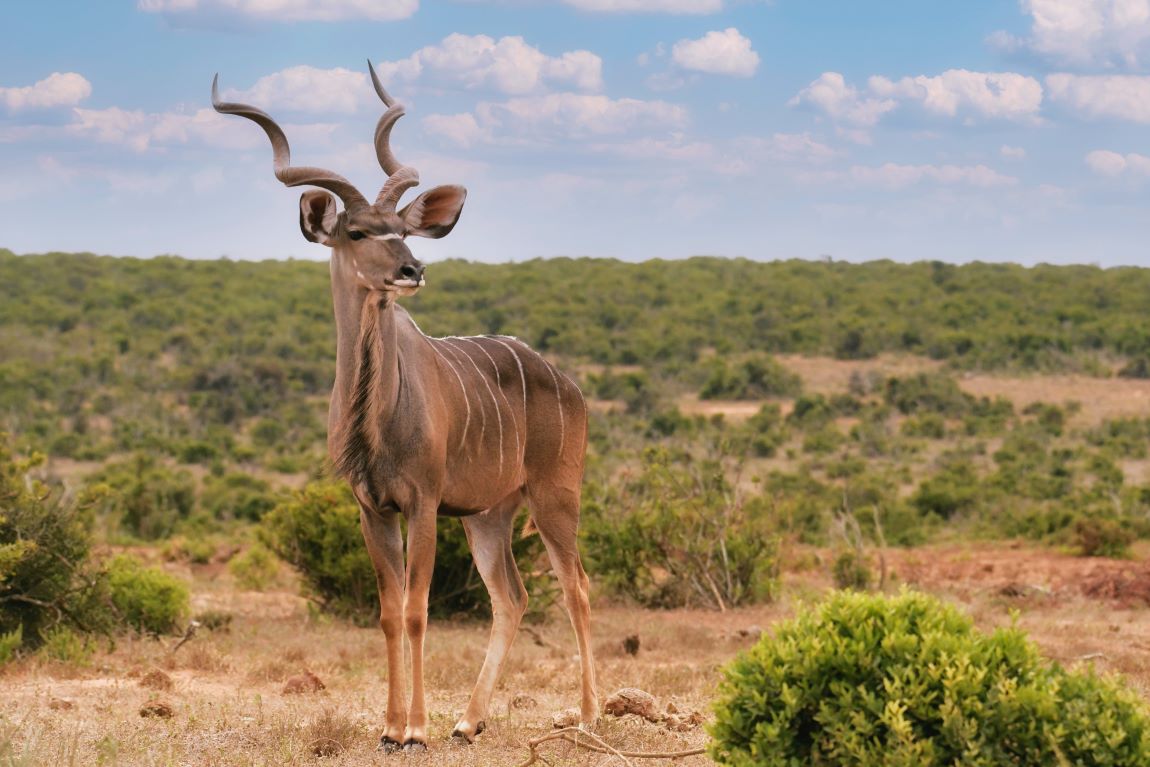Kudus are often referred to as “the king of spiral-horned antelopes,” and it is not difficult to ascertain why this African plains game species is so popular and sought-after. When God made antelopes, He was surely showing off with this one! Graceful, majestic, and downright beautiful, no African hunt is complete without targeting this big game antelope, with its magnificent spiral horns and beautiful striped coat. This antelope oozes confidence and elegance from the tip of their spiral-shaped horns to the edge of those long-hoofed legs!
Kudu hunting in Africa is an art that many hunters will struggle to perfect on the first try and return to Africa time and again to enjoy hunting this elusive African plains game trophy or to improve upon their trophy from their previous hunting safari. Luckily, Africa is a patient teacher with many tricks and tips to assist hunters in harvesting their trophy animals.
[DYNAMIC-BLOGTABLEOFCONTENT]
The Kudu at a Glance
This large, elegant antelope is often targeted on big game hunting safaris.
Before embarking on your big game hunting adventure, ensure you know how to identify this magnificent antelope that excels at camouflaging itself in the African bushveld. They are tall and striking, with a reddish-brown coat, although males also often have a grayish-brown coat. Their coats also have vertical lines running down their bodies, which greatly assist them in blending into their natural environment. They have narrow bodies and long, muscular legs. When scared or if they feel that they are in danger, they stand dead still, which assists in their camouflage.
There are two main species, the Great Kudu (Tragelaphus strepsiceros) and the Lesser Kudu (Tragelaphus imberbis).
The Greater Kudu generally has three recognized subspecies:
- s. strepsiceros: Found over most of southern Africa.
- s. chora: Inhabits northeastern Africa, including northern Kenya, Ethiopia, Somalia, Eritrea, and eastern Sudan.
- s. cottoni: Found in scattered populations in Chad and western Sudan.
The Lesser Kudu has two subspecies:
- Northern Lesser Kudu ( i. imberbis)
- Southern Lesser Kudu ( i. australis)
Differences Between the Greater Kudu and Lesser Kudu
Some of the main differences between the greater and lesser kudu are:
- Distribution
- Size
- Horns
- Habitats
The greater kudu inhabits most of southern Africa, some central African regions, and the northeastern coast. The lesser kudus distribution is limited to East Africa only.
The greater kudu is a large antelope, reaching 396-550 pounds, while the lesser kudu tips the scales around 176-220 pounds. Only males have horns, with the greater kudu having more defined and bigger horns. A set of horns between 50 and 54 inches is considered a good trophy, but horns on exceptional specimens can reach over 60 inches, while lesser kudus horns measure around 20-28 inches. The lesser kudu also has a more relaxed spiral than the tighter spiral shape of the greater kudu’s horns. Interestingly enough, and another reason to target this African plains game antelope, the greater kudu has the largest horns of any African antelope.
While the greater kudu is generally quite adaptable and inhabits assorted areas, including savannas, hilly areas, and woodlands, the lesser kudu is more poignant in its habitat of woodlands and dense scrub. Both species refrain from open areas such as grasslands.
Conservation Status
The International Union for Conservation of Nature (IUCN) lists the greater kudu’s status as that of “least concern,” while the lesser kudu is listed as “near threatened.”
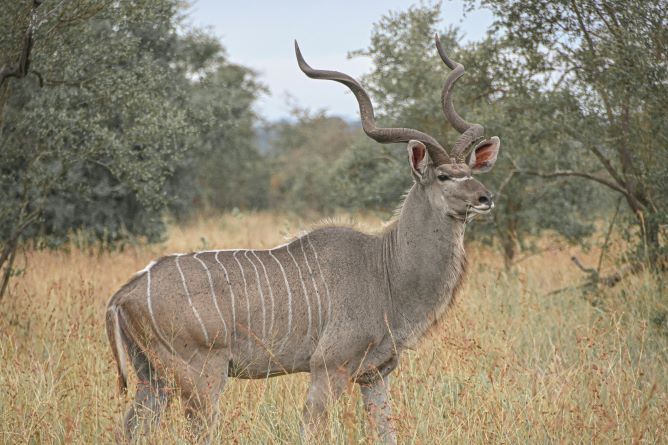
Why is the Kudu called the “Gray Ghost?”
Kudus are shy and elusive and are experts at hiding, sometimes in broad daylight and not being seen, like a ghost! Their coat coloring and stripes assist them in blending in and camouflaging themselves, allowing them to hide in plain sight.
When these big game antelopes sense danger or a perceived threat, they also stand dead still, and this, as above, allow them to “disappear” into the veld, almost like a ghost that appears and disappears. Kudus are extremely wary and alert animals, and should they sense danger, they will dart off into the vegetation and disappear almost within seconds.
Therefore, the analogy of a gray ghost seems fitting as now you see them, now you don’t!
The Challenge of Hunting Africa’s Gray Ghost
Hunters often ask if kudus are challenging to hunt, and the answer is a resounding yes. Their impeccable eyesight and large ears ensure they can see and hear every noise and murmur in the veld. I have even heard of hunters stalking kudus in their socks to ensure that they are as quiet as humanly possible! These big game antelope are constantly vigilant, making it difficult for hunters to target them.
If there were ever an animal athletics team in the bush, I’d want the kudu on my side. Not only are they fast in the veld, reaching speeds of more than 60 miles per hour, but they can easily clear 6.5 feet and have been known to clear fences and obstacles of more than 9.5 feet! We’d win for sure!
All jokes aside, the above-mentioned reasons, as well as their coat coloring with its vertical stripes, allow them to easily camouflage themselves, ensuring that kudus tick all the boxes for an immensely challenging big game hunting adventure.
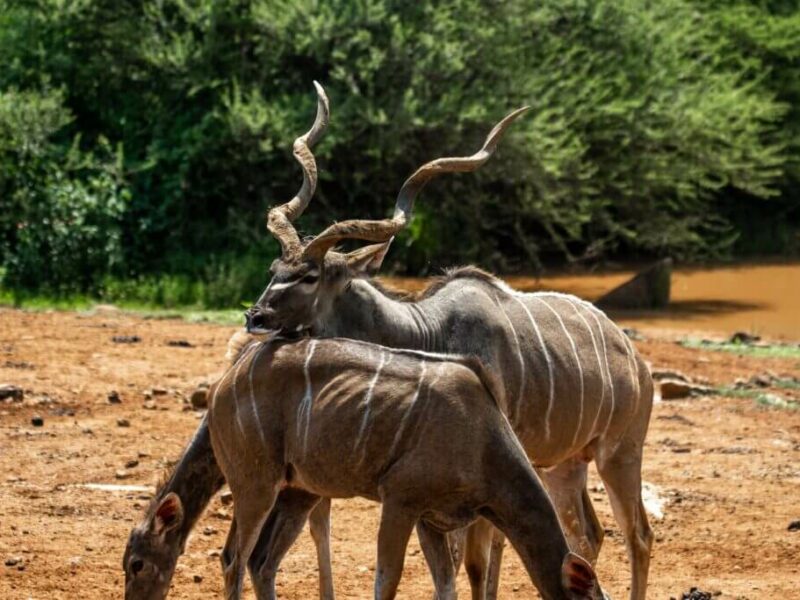
Where are the Best Destinations to enjoy Kudu Hunting in Africa?
While the greater kudu inhabits a great deal of southern Africa, some of central Africa, and East Africa, prime kudu hunting destinations include South Africa, Namibia, Botswana, and Zimbabwe. While kudu hunting safaris are available in other African countries, the countries mentioned above are some of the best hunting destinations for this mysterious African plains game species.
South Africa is a well-known destination to hunt this beautiful spiral-horned antelope, with the Eastern Cape, Limpopo, Northern Cape, KwaZulu-Natal, and Mpumalanga prime kudu hunting locations. The Eastern Cape is especially renowned for its massive trophy kudus.
Rifles, Rounds & Ammunition
A 30.06 is a good caliber choice when kudu hunting in Africa. Do not use a bullet with a weight of less than 150 grain. A .375 right up to a .458 loaded with a solid bullet is also a good option, while for distance shots, a suggestion would be to consider a 7mm or 300-win mag.
Bow hunting of kudu is practiced in many African countries. Chat to your African outfitter to find out further information.
Remember to refrain from head and neck shots to ensure your kudu trophy is undamaged during the hunting adventure.
Tips when Kudu Hunting in Africa
Hunting in Africa, they say, is not for sissies. Add to that one of the most elusive animals to hunt, and you have an exciting African hunt! Try taking some of our tips on board to assist you in targeting this shy antelope:
- The best time to target kudus is at sunrise or sunset when they are most active. Kudus are nocturnal and are most active at night while resting or sleeping during the day.
- To be able to hunt a kudu with confidence, ensure that you have completed your homework on the subject and are well-versed in the behavior and habits of the antelope.
- Speaking of being familiar with all things kudu, take the time to research and read up about shot placement on this majestic antelope. Refer to the kudu shot placement section on the website for further information and assistance.
- The hunting methods utilized in targeting the kudu are the walk-and-stalk tactic. Ensure that your fitness is good, as hunting this antelope is going to require a lot of walking. Other hunting methods include bow hunting from a blind. This requires a lot of patience, but the trophy is worth the wait!
- Kudu hunting requires much patience from hunters, the process of hunting this magnificent beast can take a while, and if the hunter startles or scares the animal, it will take off into the bush, and your trophy will vanish like mist before the sun.
- Be patient. Kudu hunting is not a simple stalk. No, this graceful antelope is one of the most difficult African plains game species to hunt, and when you do spot them, you need to ensure that THEY don’t spot you until it is too late.
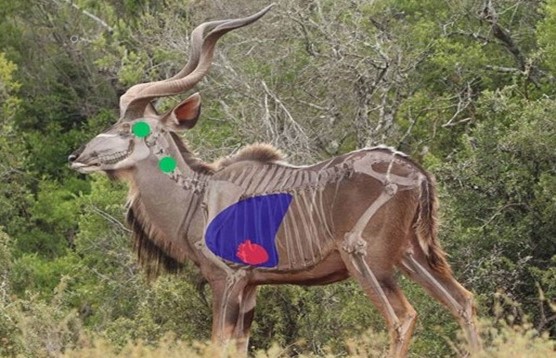
A Kudu Hunting Safari FAQs
Are kudus difficult to hunt?
Yes, these African plains game animals are some of the most troublesome animals to target on an African hunt, as not only are these antelopes challenging to spot in the first place, but they are also extremely alert.
What size kudu is considered a good trophy?
A kudu gets judged on the size of its horns. For the greater kudu, a trophy with horns of 50-54 inches is seen as a good one, while a trophy of 60 inches plus is exceptional.
How long is a kudu hunting safari?
The length of a hunt depends on many factors. For example, are you targeting just African plains game, or is the kudu included as an extra on a dangerous game hunting package?
An African plains game basic package that includes kudu can start at around three days of hunting and move upwards from there, depending on how many animals are targeted, the type of animals, etc.
Why are Kudus Popular to hunt?
Kudus are something really spectacular. They are secretive, elusive, and shy antelopes that are incredibly difficult to hunt. Therefore, hunters relish the opportunity to target this graceful and majestic African plains game antelope.
It is a striking antelope with large eyes and prominent ears, with large spiral-shaped horns that can reach up to 60 inches on an exceptional greater kudu trophy. It is unusual and remains a sought-after African game hunting trophy.
Who are the Kudus’ Predators?
The kudu’s predators include lions, leopards, wild dogs, and hyenas. While cheetahs also target kudus, they don’t possess the strength to take down a full-grown kudu male and target the old, injured, or young, along with kudu cows.
Can you eat Kudu meat?
Yes, kudu meat is called game meat, also known as venison, and is delicious! Popular choices include tartare, kudu steaks, or sosaties (kebabs) on a braai, kudu roast, or some traditional pies from the meat. Game meat is exceptionally good for you, with low fat and without any added hormones.
Of course, the most popular option would be to process the meat into kudu biltong or droewors, a South African delicacy.
When is the Best Time for a Kudu Hunt?
Depending on your location, the best time for a kudu hunt varies. If you are hunting in South Africa, the best time is during April and May, but kudu are hunted throughout the year.
For other African countries, especially those near the equator, the best time is during the dry season when the animals are more likely to congregate near a water hole.
Can I use my Bow to Hunt Kudu?
Yes, this method is becoming increasingly popular, and sees the kudu hunting adventure taking place from a blind. The blind usually overlooks a waterhole or near recent kudu activity.
Are Kudus Good Jumpers?
Yes, kudus are exceptionally good at jumping and can reach heights of 6.5 feet, and if they are stressed they can jump heights of 9.5 feet. This jumping ability is very handy to evade predators in rocky or hilly landscapes.
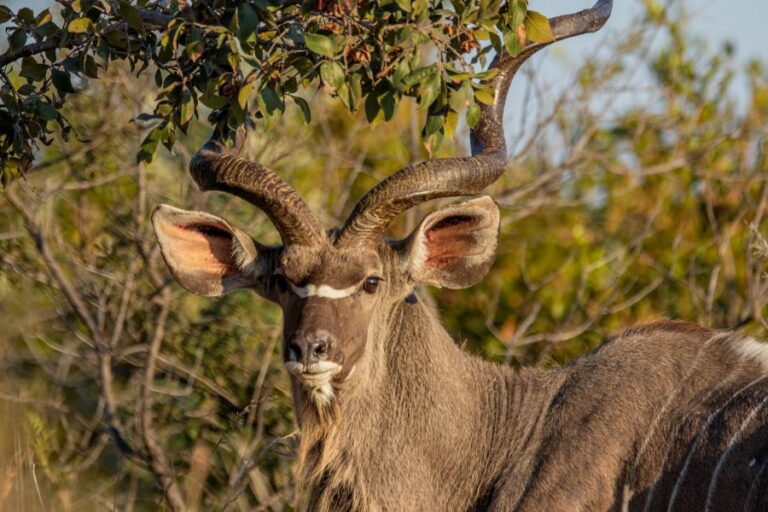
Challenging Hunt, Exceptional Trophy
Learn more about kudu hunting in South Africa in a recent blog or prepare for your kudu hunting safari by perusing an article about shot placement on a kudu.
Author: B. Hershensohnn
